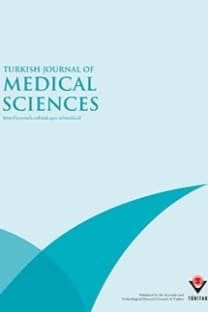Risk factors related to the size and volume of femoral artery pseudoaneurysm after catheter angiography: a single-center study
Risk factors related to the size and volume of femoral artery pseudoaneurysm after catheter angiography: a single-center study
___
- Kocaeli Üniversitesi, Tıp Fakültesi,1. Spies J.B, Bakal C.W, Burke DR, Cardella JF, Dawson S et al. Standard for diagnostic arteriography in adults. Standards of Practice Committee of the Society of Cardiovascular and Interventional Radiology. Journal of Vascular Interventional Radiology 1993; 4: 385-395.
- 2. Hirano Y, Ikuta S, Uehara H, Nakamura H, Taniguchi M et al. Diagnosis of vascular complications at the puncture after cardiac catheterization. Journal of Cardiology 2004; 43 (6): 259-265.
- 3. Katzenschlager R, Ugurluoglu A, Ahmadi A, Hülsmann M, Koppensteiner R et al. Incidence of pseudoaneurysm after diagnostic and therapeutic angiography. Radiology 1995; 195: 463- 466. doi: 10.1148/radiology.195.2.7724767
- 4. Popma JJ, Satler LF, Pichard AD, Kent KM, Campbell A et al. Vascular complications after balloon and new device angioplasty. Circulation 1993; 88: 1569-1578. doi: 10.1161/01.cir.88.4.1569
- 5. Stolt M, Braun-Dullaeus R, Herold J. Do not underestimate the femoral pseudoaneurysm. Vasa 2018; 47 (3): 177-185. doi: 10.1024/0301-1526/a000691
- 6. Muller DW, Shamir KJ, Ellis SG, Topol EJ. Peripheral vascular complications after conventional and complex percutaneous coronary interventional procedures. American Journal of Cardiology 1992; 69 (1): 63-68. doi: 10.1016/0002-9149(92)90677-q
- 7. Stone PA, Campbell JE, AbuRahma AF. Femoral pseudoaneurysms after percutaneous access. Journal of Vascular Surgery 2014; 60 (5): 1359-1366. doi: 10.1016/j.jvs.2014.07.035
- 8. Cope C, Zeit R. Coagulation of aneurysms by direct percutaneous thrombin injection. American Journal of Roentgenology 147 (2): 383-387. doi: 10.2214/ajr.147.2.383
- 9. Chen DH, Sammel AM, Jain P, Jepson NS. Cardiologist operated ultrasound-guided thrombin injection as a safe and efficacious first-line treatment for iatrogenic femoral artery pseudoaneurysms. Heart Lung and Circulation 2015; 24 (2): 165- 172. doi: 10.1016/j.hlc.2014.07.066
- 10. Demharter J, Leissner G, Huf V, Roemer FW, Vollert K et al. Treatment of iatrogenic femoral pseudoaneurysms with thrombin injection results in 54 patients. Rofo 2005; 177: 550-554. doi: 10.1055/s- 2005-857967. PMID: 15838761
- 11. Mohler ER 3rd, Mitchell ME, Carpenter JP, Strandness DE Jr, Jaff MR et al. Therapeutic thrombin injection of pseudoaneurysms: a multicenter experience. Vascular Medicine 2001; 6 (4): 241-244. doi: 10.1177/1358836x0100600407
- 12. Naddaf A, Williams S, Hasanadka R, Hood DB, Hodgson KJ. Predictors of groin access pseudoaneurysm complication: a 10- year institutional experience. Vascular and Endovascular Surgery 2020; 54 (1): 42-46. doi: 10.1177/1538574419879568. Kalp Damar Cerrahisi Anabilim Dalı, Kocaeli, Türkiye
- 13. Kalish J, Eslami M, Gillespie D, Schermerhorn M, Rybin D et al. Vascular study group of New England. Routine use of ultrasound guidance in femoral arterial access for peripheral vascular intervention decreases groin hematoma rates. Journal of Vascular Surgery 2015; 61 (5): 1231-1238. doi: 10.1016/j.jvs.2014.12.003
- 14. Ortiz D, Jahangir A, Singh M, Allaqaband S, Bajwa TK et al. Access site complications after peripheral vascular interventions: incidence, predictors, and outcomes. Circulation Cardiovascular Interventions 2014; 7 (6): 821-828. doi: 10.1161/CIRCINTERVENTIONS.114.001306
- 15. Badr S, Kitabata H, Torguson R, Chen F, Suddath WO et al. Incidence and correlates in the development of iatrogenic femoral pseudoaneurysm after percutaneous coronary interventions. Journal of Interventional Cardiology 2014; 27 (2): 212-216. doi: 10.1111/joic.12091
- 16. Moll R, Habscheid W, Landwehr P. The frequency of false aneurysms of the femoral artery following heart catheterization and PTA (percutaneous transluminal angioplasty). Rofo 1991; 154: 23-27. doi: 10.1055/s-2008-1033079
- 17. Kang SS, Labropoulos N, Mansour MA, Michelini M, Filliung D et al. Expanded indications for ultrasound-guided thrombin injection of pseudoaneurysms. Journal of Vascular Surgery 2000; 31 (2): 289-298. doi: 10.1016/s0741-5214(00)90160-5
- 18. Sheiman RG, Mastromatteo M. Iatrogenic femoral pseudoaneurysms that are unresponsive to percutaneous thrombin injection: potential causes. American Journal of Roentgenology 2003; 181: 1301-1304. doi: 10.2214/ajr.181.5.1811301. PMID: 14573423
- 19. Hoke M, Koppensteiner R, Schillinger M, Haumer M, Minar E et al. D-dimer testing in the diagnosis of transfemoral pseudoaneurysm after percutaneous transluminal procedures. Journal of Vascular Surgery 2010; 52 (2): 383-387. doi: 10.1016/j.jvs.2010.02.275
- 20. Mlekusch W, Haumer M, Mlekusch I, Dick P, Steiner-Boeker S et al. Prediction of iatrogenic pseudoaneurysm after percutaneous endovascular procedures. Radiology 2006; 240 (2): 597-602. doi: 10.1148/radiol.2402050907
- ISSN: 1300-0144
- Yayın Aralığı: 6
- Yayıncı: TÜBİTAK
Mehmet Akif ERDÖL, Kadriye GAYRETLİ YAYLA
What plays a role in the severity of atopic dermatitis in children?
Prediction of posttraumatic stress disorder by acute stress disorder in traffic accident survivors
Xiuli LI, Luyi SUN, Qiang LI, Li WANG
Kadir Uğur MERT, Göknur YORULMAZ, Selda MURAT, Muhammet DURAL, Elif Sevil ALAGÜNEY, Ahmet Serdar YILMAZ, Nur KEBAPÇI, Ezgi CAMLI, Belgin EFE, Aysen AKALIN, Ahmet Toygar KALKAN
The utility of magnetic resonance angiography in children with nutcracker syndrome
0000-0002-9785-8067, Ayşegül CANSU, Dilara ATASOY, Ayşe Füsun BEKİRÇAVUŞOĞLU, Ali AHMETOĞLU
Rahmi YILMAZ, Emine Arzu AYHAN, Neriman Sıla KOÇ, Tolga YILDIRIM, Yunus ERDEM, Müge ÜZERK KİBAR, Berranur KÜTAHYA, Fatma İŞ, Mehmet ERDEVİR
Low immunity against vaccine preventable diseases in Turkish HIV cohort
Salih ÇETİNER, Fatma ESER, Ayşe Seza İNAL, Gönül Çiçek ŞENTÜRK, Aslıhan CANDEVİR, Süheyla KÖMÜR, Yeşim TAŞOVA, Ferit KUŞCU, Behice KURTARAN, Figen YILDIRIM
Reliability and validity of the Turkish version of Post-COVID-19 Functional Status Scale
Esra KINACI, Melda SAĞLAM, Gülay SAİN GÜVEN, Ebru ÇALIK KÜTÜKCÜ, Naciye VARDAR YAĞLI, Deniz İNAL İNCE, Aslıhan ÇAKMAK, Nursel ÇALIK BAŞARAN, Oğuz Abdullah UYAROĞLU, Lale ÖZIŞIK
Allergic reactions against Covıd-19 vaccines
Ümit Murat ŞAHİNER, Bülent Enis ŞEKEREL, Hilal ÜNSAL
A single center survey study of systemic vasculitis and COVID-19 during the first months of pandemic
Lale ÖCAL, Mehmet Salih SEVDİ, Sibel ZARALI, Murat İNANÇ, Murat BEKTAŞ, Ahmet GÜL, Burak İNCE, Nevzat KOCA, Besim Fazıl AĞARGÜN, Damla Yenersu GÜZEY, Ayşe İNCE, Yasemin YALÇINKAYA, Bahar ARTIM ESEN
